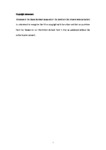The evaluation of functional feeds additives in commercial conditions with the pacific white leg shrimp
| dc.contributor.supervisor | Merrifield, Daniel | |
| dc.contributor.author | Servin, Kurt | |
| dc.contributor.other | School of Biological and Marine Sciences | en_US |
| dc.date.accessioned | 2020-10-26T15:29:05Z | |
| dc.date.available | 2020-10-26T15:29:05Z | |
| dc.date.issued | 2020 | |
| dc.identifier | 10440878 | en_US |
| dc.identifier.uri | http://hdl.handle.net/10026.1/16599 | |
| dc.description.abstract |
Given the rapid expansion of aquaculture globally and with the Litopenaeus vannamei sector making a significant contribution to seafood production, there is an urgent need to address diet and feed formulation focused on sustainability and novel ingredients, without using chemotherapeutics. This thesis explores three bioactive natural agents used in shrimp diets to mitigate the threat of disease and confer a more resilient shrimp: (i) β-glucans and yeast-derived components as functional feed additives; (ii) a blend of phytobiotic herbal extractives and yeast (YAH); and (iii) Tuna Protein Hydrolysate (TLH) as growth-promoting and immunostimulants. All studies were conducted on juvenile shrimp in cages within an open system environment under high density with fluctuating, oxygen, temperature, salinity and photoperiod. Zootechnical parameters, and indices relating to haemocyte levels for immune competence and histological assessment of the intestine, with emphasis on gut morphology and integrity, were analysed. Also, the aim was to ascertain the effect of the functional feed additives on the gut microbiota associated with their potential modulatory capacity under commercial conditions. The findings confirmed that β-glucans and yeast combinations enhanced growth and survival of juvenile shrimp. For YAH, a 1% inclusion gave excellent improvements in growth and survival. For TLH, a 2% inclusion rate gave the best overall performance. These trials revealed a marked shift in the microbial enteric community with effects on phyla but more pronounced at the genera taxonomic level. The thesis discusses these aspects for securing a more efficient shrimp production industry with a cost-benefit assessment for economic appraisal of using function feed additives in this important aquaculture sector. The results are expected to be a comparative basis for other studies, and relevant for the aquaculture industry. The findings are expected to contribute to the advance of animal nutrition and health and for the increasing of shrimp farming industry. | en_US |
| dc.language.iso | en | |
| dc.publisher | University of Plymouth | |
| dc.rights | CC0 1.0 Universal | * |
| dc.rights.uri | http://creativecommons.org/publicdomain/zero/1.0/ | * |
| dc.subject | shrimp nutrition | en_US |
| dc.subject | feed additives | en_US |
| dc.subject | gut microbiome | en_US |
| dc.subject | aquaculture | en_US |
| dc.subject.classification | PhD | en_US |
| dc.title | The evaluation of functional feeds additives in commercial conditions with the pacific white leg shrimp | en_US |
| dc.type | Thesis | |
| plymouth.version | publishable | en_US |
| dc.identifier.doi | http://dx.doi.org/10.24382/1144 | |
| dc.rights.embargoperiod | No embargo | en_US |
| dc.type.qualification | Doctorate | en_US |
| rioxxterms.version | NA |
Files in this item
This item appears in the following Collection(s)
-
01 Research Theses Main Collection
Research Theses Main



